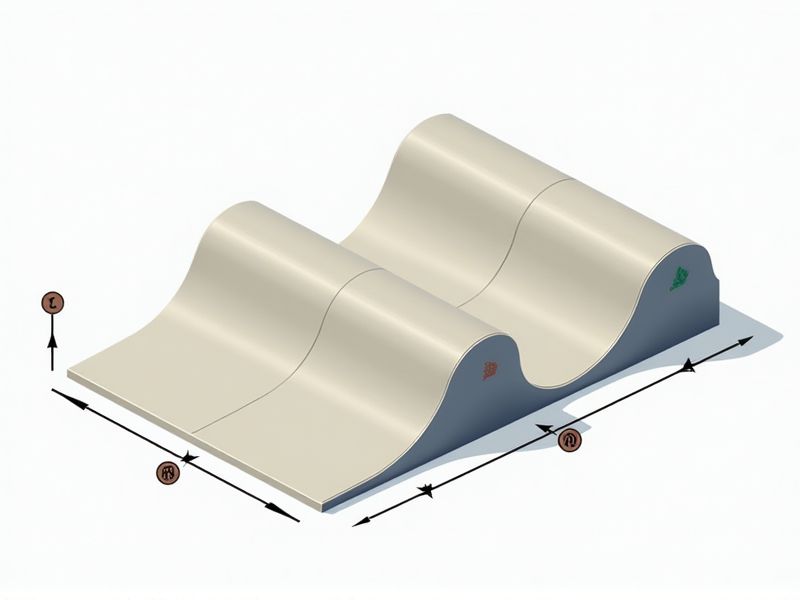
When designing or evaluating a skateboard park, it's helpful to know the standard dimensions for various features. Most public skateparks are between 8,000 and 20,000 square feet, which provides ample room for a combination of street elements (like rails and stairs) and transition features (like bowls and ramps). For example, a typical mini ramp is 3-5 feet high and 8-12 feet wide, while individual obstacles such as ledges or rails are usually 8-12 feet long. Understanding these standard dimensions ensures the park will be both accessible to beginners and engaging for experienced skaters, making it a welcoming space for the whole community.
Quarter Pipe Height
A standard skateboard park typically features a quarter pipe with a height ranging from 3 to 6 feet, catering to various skill levels. Riders often use the quarter pipe to launch into aerial tricks, with the height directly influencing the type of maneuvers possible. For advanced skaters, a 6-foot quarter pipe presents opportunities for more complex aerials, while beginners may find a 3-foot height more manageable for learning foundational skills. Ensuring proper height and smooth transition is crucial to creating an engaging and safe environment for skateboard enthusiasts.
Half Pipe Width
The standard half-pipe width in skate parks typically ranges from 24 to 36 feet, accommodating various skill levels and enabling more complex tricks. A half-pipe's design often includes a vertical wall height of at least 10 feet, allowing for greater air time and maneuverability. To ensure safety, many parks incorporate proper drainage systems that help prevent water buildup, allowing for year-round usage. If you're designing or visiting a park, understanding these dimensions can enhance your skating experience significantly.
Bowl Depth
The standard for skatepark design emphasizes bowl depth as a critical factor for skaters' versatility and skill development. A depth range of 5 to 10 feet is ideal, allowing for a variety of tricks and transitions that cater to both novice and experienced riders. Parks with varied depths encourage diverse skating styles, enhancing user engagement and community involvement. Ensuring the right bowl depth not only improves performance but also maximizes safety by promoting controlled descents and ascents.
Flat Bottom Length
A standard skateboard park typically features a flat bottom length of 30 to 40 feet, providing skaters with ample space for tricks and maneuverability. This design element enhances performance by allowing skaters to build speed and execute various stunts effectively. Proper flat bottom length is crucial for safety, as it reduces the risk of falls when transitioning into ramps or obstacles. You'll find that parks with optimized flat bottom lengths are more appealing for both beginner and advanced skaters, fostering a vibrant community atmosphere.
Ramp Gradient
The standard ramp gradient for skateboard parks typically ranges from 12% to 20%, ensuring a balance between safety and performance. A 12% gradient is more suitable for beginners, allowing for gradual acceleration and control, while a 20% gradient caters to advanced skaters seeking higher speeds and aerial maneuvers. Properly designed ramps should feature a smooth transition to prevent abrupt landings or stalling. Ensuring compliance with these gradient standards can significantly enhance the skateboarding experience while minimizing the risk of injury.
Rail Length
The standard rail length for skateboard parks typically ranges from 8 to 12 feet, providing ample space for various tricks and maneuvers. A rail length of 10 feet is common, offering an ideal balance for skaters to practice their skills. For advanced riders, rails can extend to 15 feet or more, accommodating complex tricks and promoting progression. Properly designed rails enhance safety and performance, ensuring a positive skateboarding experience for riders of all skill levels.
Hubba Height
The standard hubba height for skateboard parks ranges from 12 to 18 inches, providing an optimal challenge for skaters. This measurement allows for a variety of tricks, enhancing the park's appeal to both beginners and advanced riders. Parks that incorporate hubbas at this height often see increased foot traffic, with users citing improved skill development. Including features like ledges and handrails near the hubba can further diversify your skating experience, attracting a wider audience.
Bank Angle
Bank angle, a crucial design element for skateboard parks, typically ranges from 30 to 45 degrees to accommodate various skill levels and tricks. This specific angle influences the skating experience, allowing for smooth transitions and increased stability during maneuvers. A well-designed bank encourages skaters to maintain speed while providing a safe environment for practicing advanced techniques. For optimal performance, ensure your skateboard park's bank angle aligns with industry benchmarks, enhancing both enjoyment and safety for users.
Mini Ramp Width
The standard width of a mini ramp in skateboard parks typically ranges from 4 to 10 feet, catering to various skill levels and riding styles. Wider ramps, such as those around 8 to 10 feet, offer more space for tricks and maneuvers, making them popular among experienced skaters. For beginners, a 4 to 6-foot ramp width provides a manageable environment to develop skills and confidence. Ensuring proper transition angles and quality materials enhances safety and performance, making the mini ramp an essential feature in skateboarding facilities.
Spine Gap
A well-designed skateboard park featuring a spine gap typically includes a vertical ramp with an elevation of around 5 to 10 feet, enhancing the challenge for skaters. The spine gap itself often spans 4 to 8 feet, providing an exciting trick opportunity when transitioning between features. Proper safety measures, such as padded landing zones and surrounding barriers, are crucial for injury prevention, with a minimum recommended space of 20 feet around the feature. For an engaging experience, consider incorporating additional obstacles, such as rails or ledges, to further enrich your skateboarding sessions.
